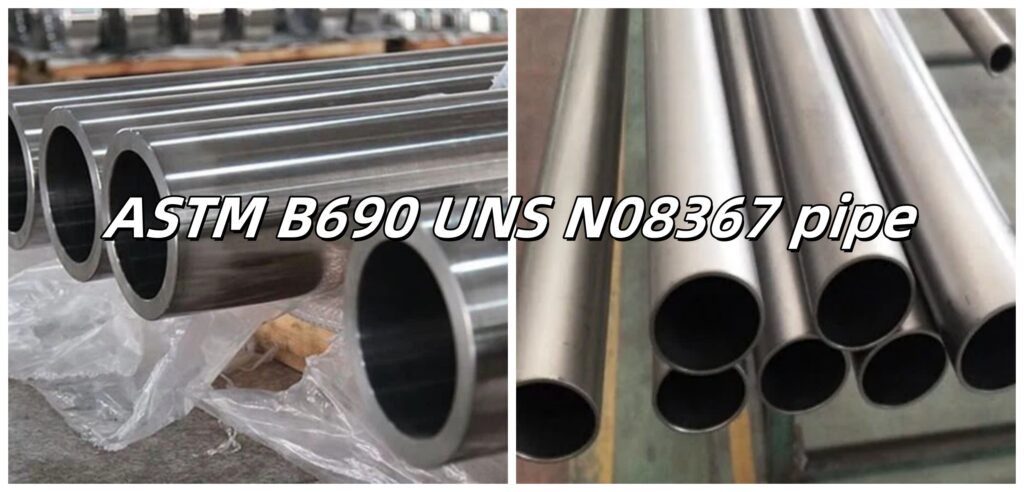
ASTM B690 UNS N08367 pipe is a high-performance, high-corrosion-resistant steel pipe material.
ASTM is the abbreviation of the American Society for Testing and Materials, which has developed a series of standards for materials, products, systems and services. The ASTM B690 standard is specifically for nickel-iron-chromium-molybdenum-nitrogen alloy seamless and welded pipes, and specifies the dimensions, tolerances, technical requirements, test methods, etc. of such pipes to ensure the quality and interchangeability of the products.
Due to its special chemical composition, ASTM B690 UNS N08367 pipe has good resistance to a variety of corrosive media, including chloride solutions, sulfuric acid, phosphoric acid, etc. In environments containing corrosive substances such as seawater, chemical industry, and food processing, it can be used for a long time without corrosion damage. For example, it is used in seawater transportation pipelines in marine engineering to effectively resist seawater corrosion.
What is nickel alloy pipe?
Nickel alloy pipe is a pipe made from an alloy that contains nickel, which gives it strength, toughness, and ductility. Nickel alloy pipes are used in many industries, including chemical, petrochemical, and power generation.
Corrosion Resistance
Nickel alloy pipes are resistant to corrosion from salt water, acid, alkaline, and hydrofluoric acid.
High Temperature Resistance
Nickel alloy pipes can withstand high temperatures, making them suitable for use in nuclear power generation and petrochemical processing.
Ductility
Nickel alloy pipes are ductile, making them easy to bend and fabricate into different shapes and sizes.
Oxidation Resistance
Nickel alloy pipes are resistant to oxidation.
Applications
Chemical processing: Nickel alloy pipes are used in heat exchangers that can withstand hot and corrosive environments.
Oil and gas extraction: Nickel alloy pipes are used in oil and gas extraction.
Aircraft systems: Nickel alloy pipes are used in aircraft systems.
Steam generators: Nickel alloy pipes are used in steam generators.
What is ASTM UNS?
The Unified Numbering System (UNS) was established to provide a standard method for identifying metallic materials. Developed by ASTM and the Society of Automotive Engineers (SAE), this system uses a series of letter and number codes to classify various alloys, ensuring consistency and clarity across industries.
ASTM B690UNS N08367 Nickel Alloy Pipe Specifications
| Size | 1/2”~48” |
| Schedule | Sch5-Schxxs |
| Type | ASTM B690 Seamless Pipes, ASTM B690 Seamless Tubes |
| Grades | UNS N08366, UNS N08367 |
ASTM B690 Standard Scope
This specification covers iron-nickel-chromium-molybdenum alloy (UNS N08367) cold-finished annealed or hot-finished annealed seamless pipe and tube intended for use in special corrosive service and for heat-resisting applications.
Pipe and tube shall be supplied in the solution heat treated and descaled condition. When bright annealing is used, descaling is not necessary.
The values stated in inch-pound units are to be regarded as standard. The values given in parentheses are mathematical conversions to SI units that are provided for information only and are not considered standard.
Terminology
Definitions of Terms Specific to This Standard:
average diameter, n—average of the maximum and minimum outside diameters, or the maximum and minimum inside diameters, as determined at any cross section of the tube.
pipe, n—seamless tube conforming to the particular dimensions commercially known as standard pipe.
tube, n—hollow product of round or any other cross section having a continuous periphery.
Hydrostatic Test
Each pipe or tube with an outside diameter 1 ⁄8 in. (3.2 mm) and larger, or tubes with a wall thickness of 0.015 in. (0.38 mm) and over, shall be tested by the manufacturer to an internal hydrostatic pressure of 1000 psi (68.9 kPa) provided that the fiber stress calculated in accordance with the following equation does not exceed the allowable fiber stress, S, indicated below:
S =(PD/2t)
where:
S = allowable fiber stress for material in cold-drawn condition, (1 ⁄4 × UTS.) 16 700 psi (1150 kPa),
P = hydrostatic test pressure, psi (or kPa),
D = outside diameter of the tube or pipe, in. (or mm), and
t = minimum wall thickness, in. (or mm), equal to the specified wall thickness minus the permissible “minus” wall tolerance, Table 3, or the specified minimum wall thickness.
ASTM B690 Chemical Requirements
| Element | Composition Limits, % | |
| N08366 | N08367 | |
| Carbon | 0.035 max | 0.030 max |
| Manganese | 2.00 max | 2.00 max |
| Phosphorus | 0.040 max | 0.040 max |
| Sulfur | 0.030 max | 0.030 max |
| Silicon | 1.00 max | 1.00 max |
| Chromium | 20.00-22.00 | 20.00-22.00 |
| Nickel | 23.50-25.50 | 23.50-25.50 |
| Molybdenum | 6.00-7.00 | 6.00-7.00 |
| Nitrogen | … | 0.18-0.25 |
| IronA | balance | balance |
| Copper | … | 0.75 max |
ASTM B690 Mechanical Properties
| Type | Condition(Temper) | Tensile Strnegth, min, ksi(MPa) | Yield Strength, (0.2% Offset), min, ksi(MPa) | Elongation in 2 in. or 50mm(or 4D), min, % |
| N08366 | Sloution treated | 75(517) | 30(206) | 30 |
| N08367 | Sloution treated | 95(655) | 45(310) | 30 |
What is uns N08367 equivalent?
UNS N08367 is equivalent to NAS254NM, SSC-6MO, INCOLOY alloy 25-6HN, and AL6XN. These are all high-corrosion resistant stainless steel alloys with high chromium and molybdenum contents.
NAS254NM
A stainless steel with high corrosion resistance that can withstand severe environments like high temperature seawater
SSC-6MO
A super-austenitic stainless steel with 6% molybdenum that resists chloride pitting, crevice corrosion, and stress-corrosion cracking
INCOLOY alloy 25-6HN
A super-austenitic stainless steel with 6% molybdenum that is strong, ductile, and resistant to corrosion
AL6XN
A super-austenitic stainless steel that is resistant to corrosion and chloride stress cracking.
These alloys are used in a variety of applications, including desalination systems, flue gas desulfurization equipment, and pharmaceutical production.
AL6XN® Alloy (UNS N08367) Dimensions
Outside Diameter and Wall Thickness:
A-The permissible variations in the outside diameter and wall thickness of pipe and tube shall not exceed those specified in Table1 , Table 2
B-Permissible variations given in Table1 , Table 2 are applicable only to two dimensions.
Length—When pipe or tube is ordered cut-to-length, the permissible variations in length shall be those specified for tubes; the permissible variation in length for pipe
shall be plus 1⁄4 in. (6.4 mm), minus 0 in.
Straightness—Material shall be reasonably straight and free of bends and kinks.
Permissible Variations in Outside Diameter, Pipe
| Permissible Variations in Outside Diameter, Pipe | ||||
| Nominal Pipe Size in. (mm) | Permissible Variations in Outside Diameter | |||
| Plus | Minus | |||
| in. | mm | in. | mm | |
| 1⁄8 (3.2) to 11⁄2 (38.1) incl | 1⁄64 | 0.4 | 1⁄32 | 0.8 |
| Over 11⁄2 (38.1) to 4 (101.6) incl | 1⁄32 | 0.8 | 1⁄32 | 0.8 |
| Over 4 (101.6) to 8 (203.2) incl | 1⁄16 | 1.6 | 1⁄32 | 0.8 |
| Over 8 (203.2) to 18 (457.2) incl | 3⁄32 | 2.4 | 1⁄32 | 0.8 |
| Over 18 (457.2) to 26 (660.4) incl | 1⁄8 | 3.2 | 1⁄32 | 0.8 |
| Over 26 (660.4) to 34 (863.6) incl | 5⁄32 | 4 | 1⁄32 | 0.8 |
| Over 34 (863.6) to 48 (1219.2) incl | 3⁄16 | 4.8 | 1⁄32 | 0.8 |
Permissible Variations in Outside DiameterA Tube
| Permissible Variations in Outside DiameterA Tube | ||
| Outside Diameter, in. (mm) | Permissible Variations, in. (mm) | |
| Plus | Minus | |
| Hot-Finished Seam | less Tubes | |
| 4 (101.6) and under | 1⁄64 0.4) | 1⁄32 (0.8) |
| Over 4 (101.6) to 71⁄2 (190.5) incl | 1⁄64 (0.4) | 3⁄64 (1.2) |
| Over 71⁄2 (190.5) to 9 (228.6) incl | 1⁄64 (0.4) | 1⁄16 (1.6) |
What is the difference between Al 6X and AL-6XN?
The primary difference between “Al 6X” and “AL-6XN” is that AL-6XN contains a significant amount of added nitrogen, which significantly enhances its corrosion resistance, particularly against pitting and crevice corrosion, compared to the original AL-6X alloy; essentially, AL-6XN is a nitrogen-enhanced version of AL-6X, making it a stronger and more corrosion-resistant option in most applications.
Key points about the difference:
Nitrogen content:
AL-6XN has a notable addition of nitrogen to its composition, while AL-6X does not.
Corrosion resistance:
Due to the nitrogen addition, AL-6XN offers superior resistance to pitting and crevice corrosion, making it more suitable for aggressive environments.
Strength:
The nitrogen also contributes to increased strength in AL-6XN compared to AL-6X.
Advantages of UNS N08367 Nickel Alloy Pipe
● Excellent corrosion resistance
● Resistant to pitting and crevice corrosion
● Resistant to uniform corrosion
● Good mechanical properties
● High strength
● High toughness
● High temperature stability
● Good weldability
Application range of ASTM B690 UNS N08367 pipe
● Chemical industry
● Chemical processing
● Petrochemical refining
● Marine engineering
● Seawater treatment system
● Submarine pipeline
● Food and beverage industry
● Environmental protection industry
● Wastewater treatment
● Waste incineration
You can get an offer for products in below material forms:
-Pipe and Tube (EN 10216-5, ASTM A213, ASTM A249, A312, A790,)
-Forged Fitting and Flange (ASTM A182 , ASTM A105,ASTM B564 )
-Butt Weld Fittings (ASTM A234, ASTM A403,ASTM A815)
-Round bar , Billet (ASTM A276, ASTM A479)
– Plate, Sheet, Strip(ASTM A240, EN 10028-7, A480)
-Bolting, Nuts(ASTM A193, A194, A320)
ASTM B690 UNS N08367 Pipe Exported Countries
We Export ASTM B690 UNS N08367 pipe to Saudi Arabia, United Arab Emirates, Qatar, Bahrain, Oman, Kuwait, Turkey, Egypt, Yemen , Syria, Jordan, Cyprus, Singapore, Malaysia, Indonesia, Thailand, Vietnam, South Korea, Japan, Sri Lanka, Maldives, Bangladesh, Cambodia, Argentina, Bolivia, Brazil, Venezuela, Colombia, Ecuador, Guyana, Paraguay, Uruguay, United States Of America, Canada, Mexico, Panama, Jamaica, Bahamas, Denmark, Norway, Germany, France,Italy, United Kingdom, Spain, Belgium, Greece, Czech Republic, Portugal, Hungary, Albania, Austria, Finland, Ireland, Croatia, Malta, Nigeria, Algeria, Angola, South Africa, Libya, Egypt, Sudan, Europe, Africa, Asia, North America, South America, Middle East.etc
